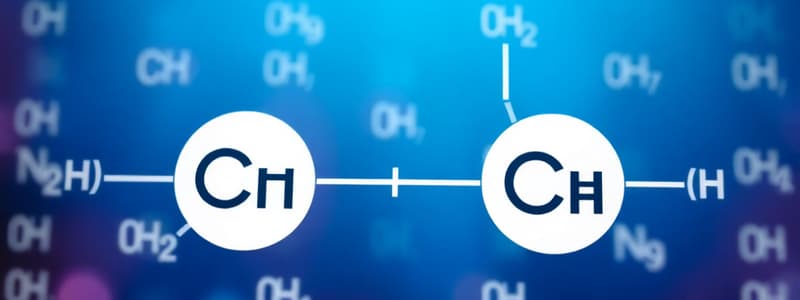Podcast
Questions and Answers
Which of the following elements contains 12 protons?
Which of the following elements contains 12 protons?
- Carbon
- Silicon
- Magnesium (correct)
- Oxygen
Cations are formed when an atom loses electrons.
Cations are formed when an atom loses electrons.
True (A)
What is the difference between ionic and molecular compounds?
What is the difference between ionic and molecular compounds?
Ionic compounds consist of metal and non-metal ions, while molecular compounds are formed from non-metal atoms sharing electrons.
In a chemical reaction, an acid and a base react to form ______ and ______.
In a chemical reaction, an acid and a base react to form ______ and ______.
Match the following types of chemical reactions with their descriptions:
Match the following types of chemical reactions with their descriptions:
What is the primary purpose of using Roman numerals in chemical nomenclature?
What is the primary purpose of using Roman numerals in chemical nomenclature?
The pH scale ranges from 0 to 14, where 7 is considered neutral.
The pH scale ranges from 0 to 14, where 7 is considered neutral.
What are diatomic molecules, and can you name two examples?
What are diatomic molecules, and can you name two examples?
A catalyst is a substance that ______ the rate of a chemical reaction without being consumed.
A catalyst is a substance that ______ the rate of a chemical reaction without being consumed.
Which of the following factors does NOT influence the rate of a chemical reaction?
Which of the following factors does NOT influence the rate of a chemical reaction?
Flashcards
Periodic Table Information
Periodic Table Information
The periodic table can tell you the number of protons, neutrons, electron shells, valence electrons, and ionic charge of an element. It also classifies elements into metals, nonmetals, and metalloids.
Cation Formation
Cation Formation
A cation is a positively charged ion formed when an atom loses electrons.
Anion Formation
Anion Formation
An anion is a negatively charged ion formed when an atom gains electrons.
Lewis Structure
Lewis Structure
Signup and view all the flashcards
Bohr Model
Bohr Model
Signup and view all the flashcards
Ionic vs. Molecular Compounds
Ionic vs. Molecular Compounds
Signup and view all the flashcards
Diatomic Molecules
Diatomic Molecules
Signup and view all the flashcards
Balancing Chemical Equations
Balancing Chemical Equations
Signup and view all the flashcards
Types of Reactions
Types of Reactions
Signup and view all the flashcards
Acids and Bases
Acids and Bases
Signup and view all the flashcards
Study Notes
Periodic Table Information
- The periodic table provides information on the number of protons, neutrons, electron shells, valence electrons, and ion charge.
- It also categorizes elements as metals, nonmetals, and metalloids.
Formation of Ions
- Cations and anions are formed through electron transfer.
Lewis and Bohr Diagrams
- Visual representations of electron arrangement in atoms and molecules.
Ionic vs. Molecular Compounds
- Differences between ionic and molecular compounds explained.
Chemical Nomenclature
- Rules for naming molecules and compounds.
- Diatomic molecules (HONC|BrIF)
- Rules for naming ionic compounds, including those involving metals with multiple valencies.
- Rules for naming ionic compounds with polyatomic ions.
- Rules for naming molecular compounds.
Chemical Equations
- Balanced chemical equations.
- Nomenclature of chemical equations (including skeletal equations and balanced equations).
- Chemical formulas.
Types of Chemical Reactions
- Synthesis reaction: Two or more reactants combine to form a single product.
- Decomposition reaction: A single reactant breaks down into two or more products.
- Endothermic reaction: Absorbs heat.
- Exothermic reaction: Releases heat.
- Single replacement reaction: A reaction where one element replaces another in a compound.
- Double replacement reaction: A reaction where the positive ions in two ionic compounds exchange.
- Combustion reaction: A reaction with oxygen that releases heat and light.
Acids and Bases
- Definition of acids and bases
- pH scale
- Neutralization reaction: Reaction between acid and base to produce salt and water.
Factors Affecting Reaction Rate
- Temperature
- Concentration
- Surface area
- Catalyst
Studying That Suits You
Use AI to generate personalized quizzes and flashcards to suit your learning preferences.



